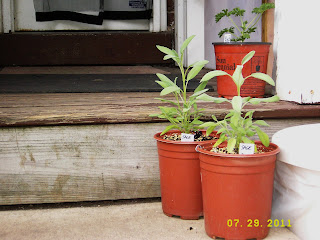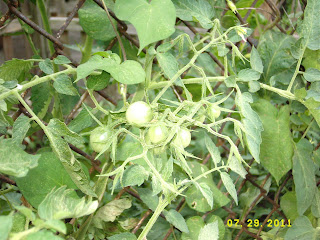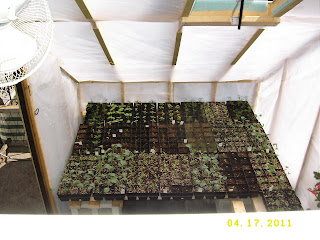 |
| base camp with yellow jewelweed in the foreground |
 |
| Chocolate Cherry tomatoes, green jalapenos, sweet Costa Rican Red Peppers and a Black Beauty Eggplant from our garden next door. |
Garden update. The garden we planted in our neighbors’ yard is growing beautifully. We have gotten plenty of big, juicy Mortgage Lifters, Cherokee Purples, Pink Brandywines and Black Krims and a multitude of little Chocolate Cherry tomatoes - so many we have to share with our other neighbors! The sweet basil plant is tall and stately, and produces far more than I can use at any one time, which necessitates more sharing and preservation.
We have gotten one big shiny Black Beauty eggplant so far, a couple of large, elegant Costa Rican Sweet Red Peppers that are absolutely delicious and several handfuls of hot green jalapenos. Our bell pepper plants are producing good-looking peppers, but I’m letting them grow bigger before harvesting. J The good thing about gardening behind a fence in the middle of the city is that there are no deer.
Sadly the tomatoes in the greenhouse did not set any fruit this season - with the notable exception of the Chocolate Cherry tomato plant. The Roma hybrid produced a few very small tomatoes, but only the Chocolate Cherry could withstand the extreme heat and humidity created by the greenhouse cover being left on all summer. We had been hoping to produce tomatoes in our yard, but instead will have to appreciate the results of this sort of misguided “field test.”
Transplants that were rootbound when I up-potted them didn’t do anything. It really isn’t worth the trouble to mess with rootbound plants. Also, I learned that parsley really needs a big container, probably 18” or so, to fulfill its culinary destiny. The parsley in the ground next door is huge and loaded with big deep-green leaves.
 |
| Pizza in progress. Fresh basil and fresh thyme are essential ingredients in my pizza sauce. |
I would only recommend attempting to can by yourself if you are already experienced in this process. Fortunately I have a lot of memories from a childhood blessed with lots of homegrown food. Dad maintained a good-sized vegetable garden and kept bees. My mother baked bread, processed honey, and canned and froze all sorts of fruits & vegetables when my sister and I were growing up. I remember my Grandma would always come over to help her on canning day, and we girls would get involved too. A few weeks ago, my sister and I shared a wonderful day together canning dozens of quarts of peaches!
Canning is a food-preservation technique that is enjoying a renaissance as more and more people want to master the art of storing their own harvest in a way that does not require ongoing energy input (i.e. freezing). As we find ourselves moving forward into an uncertain future, it can be comforting to know at least you’ll be able to eat round red tomatoes from your own garden, or peaches from a local farm during the dead of winter. The image of shelves lined with jewel-like jars of green beans, peach halves, applesauce, apple butter, peach butter, salsa, whole tomatoes, tomato sauce, jam, and honey satisfies some of that archetypal need for your own personal food security.
Here is a link to the Ball Canning & Food Preservation site:
Another great source of info about canning is the Presto Pressure Canner website:
I think it’s interesting reading, if only to understand the nature of your food a little better.
 |
| Sweet Costa Rican Red Pepper and Jalapeno, ready to become pizza toppings! |
Experience of time. When we first began our ERB Gardens endeavor in the early spring, I knew that we had a lot to learn about timing. Learning to understand what time it is, not by the clock but by nature, is a skill that we have largely lost as dwellers in urbanized human society. Ancient Greek philosophers differentiated between these two qualities of time and named them chronos and kairos. I think people are most familiar with the way these types of time intersect through their experience in the kitchen. For example, you can go by the recipe, but when your nose says the cookies are done, you take them out of the oven even if they haven’t baked as long as the recipe says.
From wikipedia: “Kairos (καιρός) is an
Living and working out in the wild blue yonder evokes your awareness of kairos. Though we use chronos to measure how long we work, the “when” of our work is directed by kairos, as is the bigger picture of food production. Living in kairos time means you wake up when you hear the rain falling on your tent roof, or hopefully just before the sun comes up. When the cool of the morning gives way to the heat of midday, you stop working and rest. When the shadows begin to lengthen in the afternoon and the hues bend towards orange and purple, you resume work until the light fades in the evening. It means you gather wood and water, consolidate & make a mental map of your campsite before darkness falls.
| afternoon break - sharpening the chain saw blades |
Linear time falls away as you begin to live in more direct relationship to your environment. Your senses and appetites become sharpened, untethered from the flickering umbilicus of the television set or the internet and honed to interpret the signals of the world around you. Your senses expand in nature the way millions of years of evolution designed them to work, and your mind returns to balance. Returning to the city is a difficult transition -requiring a great contraction of the senses and re-installation of the filters that allow you to function “normally” in the structured urban environment. It’s like going between two worlds - the world of the wild, and the world of the caged. If we can be receptive to the world of the wild, it can nurture the spirit, heal us & remind us how we are supposed to feel. This is why I think people have a deep inborn need to be in nature. It gives meaning to the rest of our lives and lets us know we are just tiny elements in a much bigger picture. I’m still puzzling over what nature needs from us.
 |
| fields before clearing, taken from the edge of the forest |
 |
| Honey on the tractor. cleared field in background except for the autumn olive shrubs |


































